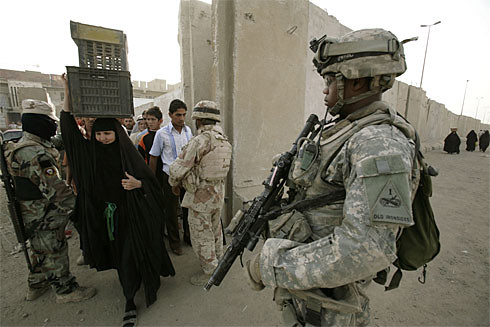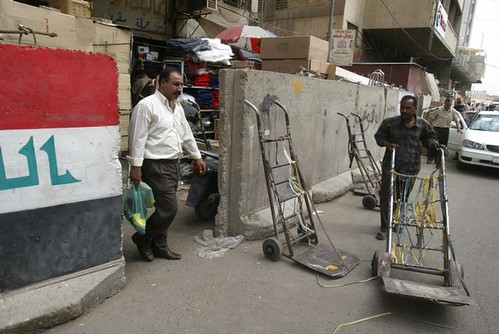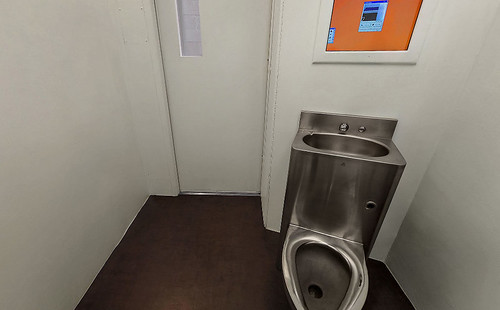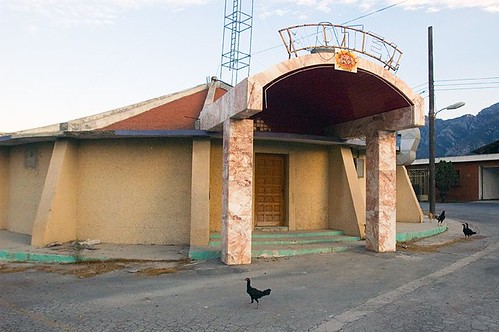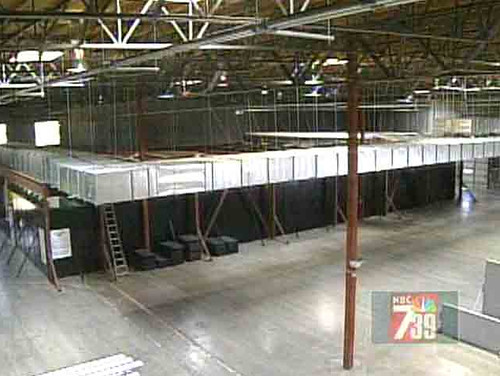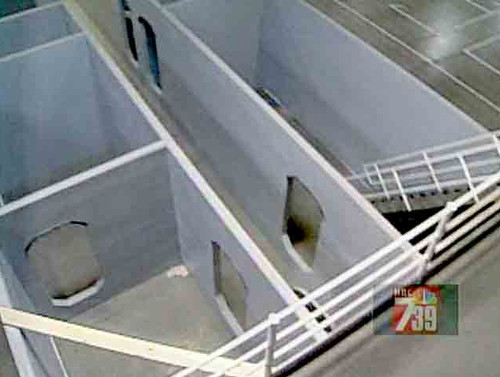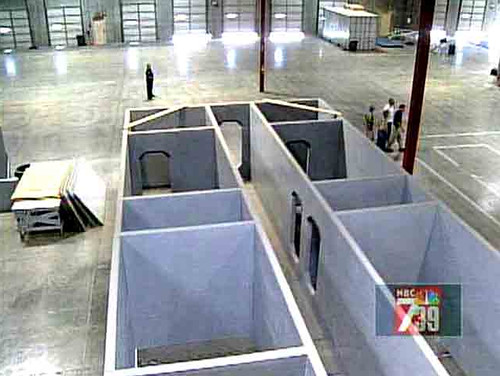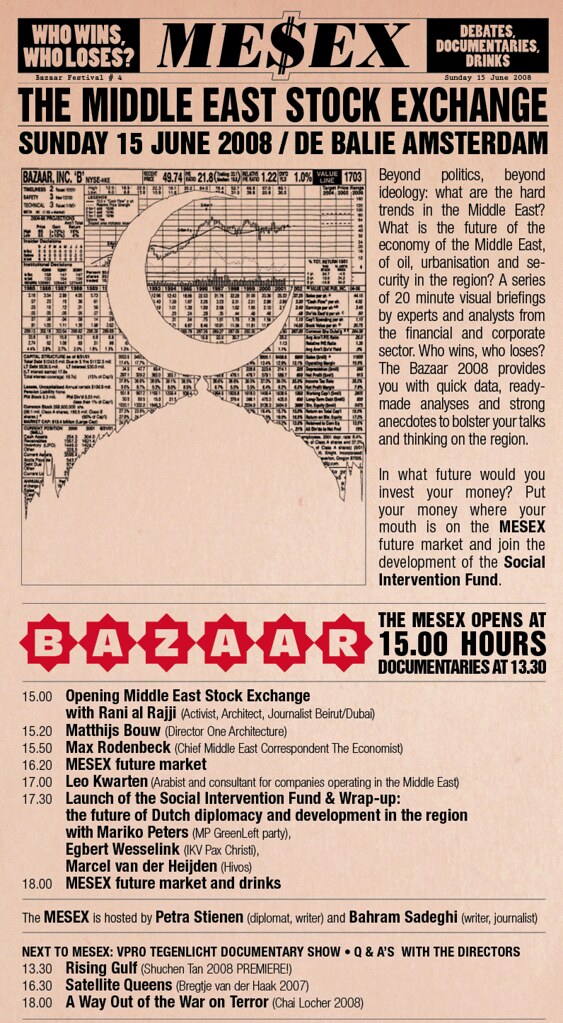 [Image: A shooting range at a new Blackwater training facility is seen Thursday, June 5, 2008, in San Diego. (AP Photo).]
[Image: A shooting range at a new Blackwater training facility is seen Thursday, June 5, 2008, in San Diego. (AP Photo).]Last month Blackwater sued city officials in Otay Mesa after they refused to issue final occupancy papers without a vote by the planning commission, even though building inspectors had already rubber-stamped the necessary permits. As you may have read, lawyers for the city said the company deceived inspectors by applying for various permits under different names of affiliated contractors instead of filing a single comprehensive application to open a counterterrorism training facility practically yards from the border. Just last Wednesday, a District Court Judge
ruled in favor of Blackwater saying the company was not required to seek any sort of special approval since the neighborhood is already zoned for appropriate vocational school use.
Facing the deadline of a fat Navy contract already in hand, Blackwater seems to have won this one. Or, at least temporarily. The “vocational training center” in Otay Mesa is open and has been immediately put to use training the Navy on special counterterrorism tactics. After being run out of Potrero by the local community there who vehemently opposed Blackwater’s plan to turn 824 acres of their precious Valley land into a shooting range, the man child merc company decided to deploy their tactics even closer to the action along the highly sensitive border with Mexico. Ray Lutz, coordinator for
Citizens' Oversight Projects (COPs), had this to say in response to the audit report of Blackwater’s permits provided by the City of San Diego on June 6.
"The audit report completely sidestepped the most important issue: how Blackwater used the various permits and multiple identities to allow processing of the mercenary-type training facility under rubber-stamp 'Ministerial' review instead of allowing the public to review and approve their plans under 'Discretionary' processing. Finally, suing the city in federal court to force the permits to be issued steps far over the line of propriety, a blatant violation of traditional local control traditions. The character of Blackwater can be seen in these actions. This is not the sort of operation we want in this county, whether it is in Potrero or in Otay Mesa."
Obviously, Blackwater wasn’t confident about applying for the project straight up, which makes me wonder, had they done so would they have been able to garner approval going through the fully vetted public process? If not, what does this say about that old paradox that I seem so obsessed with, about politics and space mutually constituting one another? Was it the fact that this is a controversial facility that more or less required deceptive political tactics for its realization; or, is it the deceptive politics that ultimately paved the way for the training facility?
Nevertheless, the feds obviously have Blackwater’s back while padding their pockets with gobs of cash, and now the question remains, what exact role will Blackwater fulfill as the fastest growing private military company in the world setting up camp right on the U.S.-Mexico border?
Jeremy Scahill, Blackwater’s public scrutinizer number 1, wrote another relentlessly expository piece for
The Nation, showing us further the vast trenches Blackwater seems to have in place to help root them politically, economically, and militarily, as a new top war profiteering dog on the block.
Let me quote him at length:
In September it was revealed that Blackwater had been "tapped" by the Pentagon's Counter Narcoterrorism Technology Program Office to compete for a share of a five-year, $15 billion budget "to fight terrorists with drug-trade ties." According to the Army Times, the contract "could include antidrug technologies and equipment, special vehicles and aircraft, communications, security training, pilot training, geographic information systems and in-field support."
Such an arrangement could find Blackwater operating in an arena with the godfathers of the war industry, such as Lockheed Martin, Northrop Grumman and Raytheon. It could also see Blackwater expanding into Latin America, joining other private security companies well established in the region. The massive US security company DynCorp is already deployed in Colombia, Bolivia and other countries as part of the "war on drugs." In Colombia alone, US military contractors are receiving nearly half the $630 million in annual US military aid for the country. Just south of the US border, the United States has launched Plan Mexico, a $1.5 billion counternarcotics program. This and similar plans could provide lucrative business opportunities for Blackwater and other companies. "Blackwater USA's enlistment in the drug war," observed journalist John Ross, would be "a direct challenge to its stiffest competitor, DynCorp -- up until now, the Dallas-based corporation has locked up 94 percent of all private drug war security contracts." The New York Times reported that the contract could be Blackwater's "biggest job ever."
As populist movements grow stronger in Latin America, threatening US financial interests as well as the standing of right-wing US political allies in the region, the "war on drugs" is becoming an increasingly central part of US counterinsurgency efforts.
And that’s really only the tip of Jeremy’s revelatory iceberg. He talks about the company’s diverse range of services that’s allowing them to fill the need and niche of many approaches to the War On Terror, from counterterrorism, to counter narco insurgency, aviation, to other militarization projects that could be used domestically like the
Grizzly, or their
border blimps. More alarming, he breaks down Blackwater’s connections with the CIA and their latest moves to privatize the intelligence industry with a secretive project called Total Intelligence Solutions. I’ll stop there and let you go read it for yourself to get the specifics. Scahill is a bad ass so look for an updated softbound edition of
his bestselling book
soon, and while you are at it, and go meet him at
this protest tomorrow outside the Otay Mesa facility.
 [Image: Chris Curry, The Virginia Pilot]
[Image: Chris Curry, The Virginia Pilot]From
Subtopia’s concern, Blackwater’s down there on our precious border, flaunting their services to any enforcement agency who will buy them, and getting their trigger-happy fingers ready to pilfer the war machine’s great
megacontract jar, and we can only speculate what this will spell out for the future of border violence, profiteering, privatization of enforcement agencies, and forthcoming spatial projects down there where obviously Blackwater has managed to bypass the public process.
According to this
AP report, “the pride of the facility is the mock warship area, where shipping containers are outfitted with red lights to simulate an onboard emergency and speakers blare clanking background noise during exercises.”
“On Thursday, workers were reinforcing a maze of wooden walls appended to the cargo containers at the request of city inspectors, who are still reviewing Blackwater's application to use the simulated ship area under an amusement-park ride permit, Bonfiglio said.”
 [Image: The Blackwater Grizzly / Is that one of the tents from the Raymondville Immigration Detention facility, in the background? Nah, looked like it though for a second.]
[Image: The Blackwater Grizzly / Is that one of the tents from the Raymondville Immigration Detention facility, in the background? Nah, looked like it though for a second.]I’ve
ranted on this a little already before, but one of the most poignant comments came from San Diego City Councilmember Ben Hueso, who represents the 8th District where the project is located. He
said, "This is a private company that would profit from instability and insecurity at the border. It's their motive and it's their interest that we have conflict and that we have problems at the border. The more there are, they more they'll profit. This is why we do not want private companies engaging in national security objectives. It is a complete conflict of interest when you mix corporate profits with community benefit."
And so now it looks like Blackwater will sink its claws deep into the War On Drugs, as a kind of expanded War On Terror campaign, 'cause there's always a war to be fought, right? Where would America be if they weren't out fighting some war? May as well fold them all into one, beef up the contracts, treat everyone as a terrorist. What will Chertoff plan next? More privately run immigrant prisons? In addition to the 670 miles of border fence, a dozen new surveillance drones, expanded mileage of newly revised virtual border fencing, let me guess, a roving wall of Blackwater mercs filling in the gaps across the 2,000 mile stretch? Since he wouldn’t be using the state’s Army to do this, maybe Bush could still claim that the U.S. isn’t technically militarizing the border?

